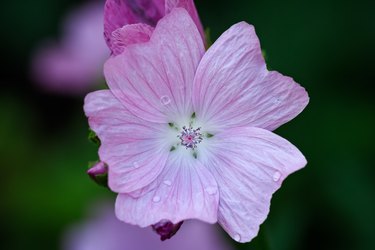
The hibiscus evokes a lush, tropical oasis, but its hardy varieties can bring this beauty into your landscape in colder climates. In fact, if you're looking for an alternative to the warmth-loving Chinese hibiscus, look no further than the hardier varieties of hibiscus. But if your garden already sports one or more hibiscus and you really are just curious about other hibiscuslike flowers, there are indeed several other flower genera and species that offer similar blooms.
The Hibiscus Genus Deconstructed
Video of the Day
There is much confusion about hibiscus because the plants commonly just referred to as "hibiscus" may be quite different from one another and have completely different growing requirements.
Video of the Day
There are three main plants whose common moniker is "hibiscus": Chinese hibiscus (Hibiscus rosa-sinensis, USDA hardiness zones 9 to 11), hardy hibiscus (H. moscheutos, zones 5 to 9), and rose of Sharon (H. syriacus, zones 5 to 8). Other plants in the Hibiscus genus are not commonly called "hibiscus," but the three plants commonly referred to as hibiscus all have showy flowers with five petals, ranging from 3 to 6 inches in diameter with a prominent central staminal column.
Plant size varies. Rose of Sharon can grow the largest, from 8 to 12 feet, while Chinese hibiscus and hardy hibiscus reach 4 to 6 feet and 3 to 8 feet, respectively.
More Hibiscus: The Rose Mallows
To muddy the waters, other flowers within the Hibiscus genus are not generally referred to as hibiscus, although they are similar: scarlet rose mallow (H. coccineus, zones 6 to 9), smooth rose mallow (H. laevis, zones 4 to 9), and just rose mallow (H. lasiocarpos, zones 5 to 9). And even though "hardy hibiscus" is also sometimes called "swamp rose mallow," these three are the primary plants gardeners are referring to when using the term "rose mallow."
Rose mallows also feature similar blooms with five petals and a showy central stamen. Colors vary widely because all these plants have been heavily hybridized but can include pink, white, lavender, and red.
Same Family, Different Genus: Malva
The genus Hibiscus is within the family Malvaceae, a large family of about 240 genera and over 4,000 species. Among its more common species are cotton, cacao, okra, and, of course hibiscus, which accounts for about 550 species. (Remember that in botany, a family contains genera, which contain species). The Malvaceae family also includes the genus Malva. In this genus, the flower of the musk mallow (Malva moschata but sometimes assigned to a different botanical genus, Abelmoschus moschatus, zones 9 to 11) quite strikingly resembles a typical five-petaled hibiscus flower, but the flowers last for just a single day, and the plants themselves are hardy perennials rather than woody, deciduous shrubs.
Same Family, Another Genus: Lagunaria
There is another plant named hibiscus! But this one is less common and is of another genus, Lagunaria, although it's still within the family Malvaceae. The Norfolk Island hibiscus (Lagunaria patersonii, zones 9 to 11) is another warmth-loving specimen with flowers that resemble those of typical hibiscus, although smaller at 2 inches across.
More commonly called a tree than a bush, the Norfolk Island hibiscus is fast-growing and evergreen, typically growing 20 to 30 feet high, although it can reach 50 feet. This tree is frequently planted as an ornamental street tree in California, Florida, and Hawaii.